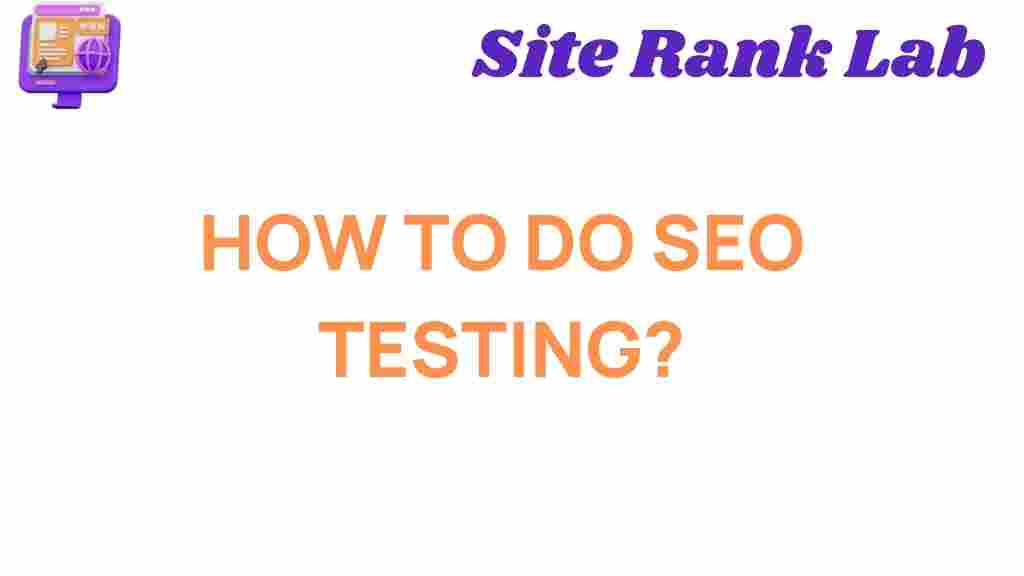Unlocking SEO Testing: Essential Strategies for Success
In the ever-evolving landscape of digital marketing, effective SEO testing has become a crucial component for achieving optimal website optimization. As businesses strive to improve their search rankings and enhance user experience, understanding the intricacies of SEO testing is essential. This article will explore the fundamental strategies for successful SEO testing, covering aspects such as analytics, A/B testing, conversion rates, and more.
Understanding SEO Testing
SEO testing involves experimenting with different elements of your website to determine what works best for improving your search engine visibility and user engagement. By using analytics to track the performance of various strategies, businesses can make informed decisions that lead to better outcomes.
Why is SEO Testing Important?
- Improves Search Rankings: Regular testing helps identify the best practices that can elevate your website’s position on search engine results pages (SERPs).
- Enhances User Experience: A well-optimized website leads to better user experience, which can decrease bounce rates and increase engagement.
- Boosts Conversion Rates: By testing different approaches, businesses can find the most effective ways to convert visitors into customers.
- Informs Digital Marketing Strategies: Insights from SEO testing can guide your overall digital marketing strategy for better results.
Essential Strategies for SEO Testing
To effectively implement SEO testing, consider the following strategies:
1. Define Your Goals
Before launching any testing initiative, you must clearly define what you aim to achieve. Possible goals include:
- Increase organic traffic
- Improve search engine rankings
- Enhance user engagement
- Boost conversion rates
Having clear objectives will help you measure the success of your tests and determine the next steps.
2. Utilize Analytics Tools
Analytics tools are vital for tracking the performance of your website. Tools such as Google Analytics provide valuable insights into user behavior, traffic sources, and conversion rates. Here’s how to use analytics effectively:
- Monitor key performance indicators (KPIs) like bounce rate, average session duration, and conversion rate.
- Segment your audience to understand different behaviors and preferences.
- Set up conversion tracking to measure the effectiveness of your SEO strategies.
3. Implement A/B Testing
A/B testing is a method where you compare two versions of a webpage to see which one performs better. This can be particularly useful for:
- Title tags and meta descriptions
- Call-to-action (CTA) buttons
- Content layout and design
- Landing page variations
By analyzing user interactions, you can determine which version resonates more with your audience and leads to higher conversion rates.
4. Optimize for User Experience
User experience (UX) plays a critical role in SEO. A website that provides a seamless experience is more likely to retain visitors and convert them into customers. Consider the following UX optimization strategies:
- Ensure fast page load times.
- Make navigation intuitive and straightforward.
- Use responsive design to accommodate mobile users.
- Incorporate clear and compelling CTAs.
5. Continuous Monitoring and Adjustments
SEO is not a one-time effort; it requires continuous monitoring and adjustments. Regularly review your analytics data and be prepared to tweak your strategies based on performance. This might involve:
- Updating content to keep it relevant and valuable.
- Refining keyword strategies based on search trends.
- Testing new SEO tactics as they emerge.
Troubleshooting Common SEO Testing Issues
Even with the best strategies in place, you may encounter some challenges during your SEO testing journey. Here are some common issues and their solutions:
1. Low Traffic Post-Test
If your traffic drops after implementing changes, consider the following:
- Revert to the previous version and analyze what went wrong.
- Check for technical issues that may have arisen, such as broken links or slow loading times.
- Ensure that the changes align with user expectations and preferences.
2. Inconsistent Analytics Data
Inconsistent data can lead to confusion. To address this:
- Double-check your tracking setup to ensure it is correctly measuring all relevant metrics.
- Ensure that filters in your analytics tools are not skewing data.
- Review any recent changes to your website that may have affected data collection.
3. Poor User Feedback
If users are providing negative feedback following changes, it may be time to reassess. Consider the following steps:
- Gather qualitative feedback through surveys or user testing sessions.
- Analyze user behavior data to identify specific pain points.
- Revisit your original goals and ensure that the changes align with user needs.
Conclusion
Effective SEO testing is key to unlocking your website’s potential and achieving long-term success in the digital marketing landscape. By employing essential strategies such as defining your goals, utilizing analytics, conducting A/B testing, optimizing for user experience, and continuously monitoring results, you can significantly improve your website optimization. Remember that SEO is a dynamic field; staying adaptable and responsive to changes will help maintain and enhance your search rankings.
For more insights on digital marketing strategies, check out this comprehensive guide. Additionally, consider using advanced analytics tools to further enhance your conversion rates and overall performance.
Start implementing these strategies today to see substantial improvements in your online presence and business success!
This article is in the category SEO and created by SiteRankLab Team
